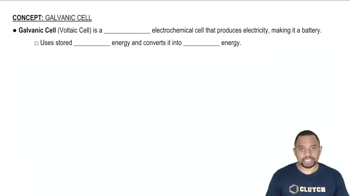Here are the essential concepts you must grasp in order to answer the question correctly.
Galvanic Cell
A galvanic cell is an electrochemical cell that converts chemical energy into electrical energy through spontaneous redox reactions. It consists of two electrodes: an anode and a cathode, immersed in electrolyte solutions. The anode undergoes oxidation, releasing electrons, while the cathode undergoes reduction, gaining electrons. This flow of electrons from the anode to the cathode generates an electric current.
Recommended video:
Electrode Polarity
In electrochemistry, electrodes are classified as either anodes or cathodes based on their roles in the electrochemical reaction. The anode is where oxidation occurs and is considered the negative electrode, while the cathode is where reduction takes place and is deemed the positive electrode. This distinction is crucial for understanding the direction of electron flow and the overall functioning of the cell.
Recommended video:
Reduction and Oxidation
Reduction and oxidation are complementary processes in redox reactions. Oxidation involves the loss of electrons, while reduction involves the gain of electrons. In a galvanic cell, the cathode is the site of reduction, where electrons from the external circuit are accepted by the species in the electrolyte. This electron gain at the cathode is what makes it the positive electrode, as it attracts electrons from the anode.
Recommended video:
Oxidation and Reduction Reactions
 Verified step by step guidance
Verified step by step guidance


